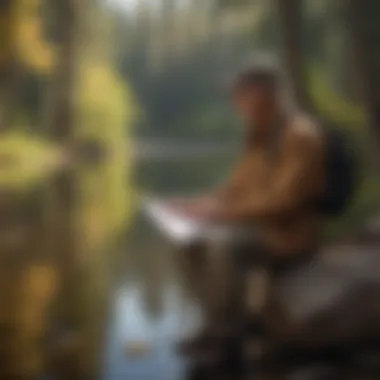Essential Guide to Colorado Fishing Permits Explained


Intro
As Colorado's vast landscapes entice both seasoned anglers and novices, understanding the state's fishing permits is crucial. The intricacies surrounding these permits are often misunderstood. This article aims to clarify these aspects, ensuring responsible fishing and compliance with legal requirements. Fishing permits not only allow recreational activities but also enforce regulations that protect aquatic ecosystems throughout Colorado.
The fishing experience is not solely about the thrill of the catch; it's also about appreciating the delicate balance of nature. By exploring the important elements of fishing permits, readers will gain insights that lead to better practices and a deeper respect for aquatic life.
Types of Colorado Fishing Permits
Fishing in Colorado requires different permits based on various criteria, such as age, residency, and type of fishing. Understanding these distinctions can provide clarity to anglers.
Resident and Non-Resident Permits
Colorado offers distinct permits for residents and non-residents, ensuring that the local ecosystems are managed effectively. Residents often receive lower fees, promoting local engagement in conservation efforts.
Youth Permits
Aimed at encouraging youth participation, these permits are often free or discounted. They help foster a love for fishing from an early age, which can lead to lifelong conservationists.
Day and Annual Permits
Depending on the duration of the fishing activity, anglers can choose between day permits or annual permits. Day permits provide flexibility for casual fishing trips, whereas annual permits cater to those who fish frequently.
Application Process for Fishing Permits
Navigating the application process for Colorado fishing permits can initially seem daunting, but knowing the steps simplifies it significantly.
- Determine the type of permit: Based on residency status and age, choose the appropriate fishing permit.
- Visit the official website: The Colorado Parks and Wildlife website is the primary resource for permits.
- Complete the application: Provide necessary details and make any applicable payments.
- Receive and print the permit: Once approved, print the permit before heading to the waters.
Regulations and Compliance
Regulations in Colorado fishing are designed to protect fish populations and aquatic environments. Anglers must comply with species-specific rules, as well as size and bag limits.
Importance of Regulations
Fishing regulations prevent overfishing and ensure that ecological balance is maintained. Understanding these rules helps mitigate negative impacts on local fish populations and supports broader conservation initiatives.
Environmental Implications of Fishing
Fishing practices can significantly affect local ecosystems. Awareness of the environmental consequences of fishing can lead to more sustainable behaviors among anglers.
Conservation Strategies
Anglers should consider strategies that minimize negative impacts on ecosystems, such as:
- Catch and Release: This practice allows for fish populations to thrive while still enjoying the sport.
- Using Barbless Hooks: Less harm is inflicted on fish, allowing for easier release.
- Proper Waste Disposal: Ensuring that littering does not harm aquatic environments.
The End
Intro to Colorado Fishing Permits


Fishing in Colorado is not just a leisurely pastime; it represents a vital connection between wildlife conservation and recreational enjoyment. Understanding fishing permits in this state is essential for both regulatory compliance and ethical fishing practices. This introduction aims to shed light on the importance of fishing permits and to provide an overview of Colorado's diverse fishing landscape.
Importance of Fishing Permits
Fishing permits are not merely bureaucratic requirements but play a critical role in sustaining aquatic ecosystems. They regulate fish populations and promote responsible angling practices. Permits help in funding conservation efforts, maintenance of fishing habitats, and enforcement of laws that protect resources. Anglers purchasing these permits contribute to necessary funding for programs that manage and preserve aquatic wildlife, ensuring future generations can also partake in this rewarding activity.
Moreover, fishing permits signify angler accountability. They ensure that individuals are informed about the local regulations, such as species limits and size restrictions. This reduces overfishing and helps maintain healthy fish populations, which is essential for biodiversity. The importance of these permits extends beyond individual benefit; they are central to environmental stewardship.
Overview of Colorado's Fishing Landscape
Colorado boasts a rich and varied fishing environment. The state encompasses diverse habitats, from serene mountain lakes to flowing rivers and sprawling reservoirs. Species such as trout, bass, and pike inhabit these waters, offering a range of opportunities for different fishing styles. The geographical diversity influences not only the species composition but also the techniques anglers use.
The state's commitment to healthy aquatic ecosystems is reflected in various catch-and-release regulations that many locations enforce. These regulations aim to maintain fish populations, thus enhancing the overall fishing experience. Anglers can expect to find both well-stocked waters and more challenging locations, encouraging both novice and experienced fishers to explore.
Types of Fishing Permits in Colorado
Fishing permits are an essential element of Colorado’s robust fisheries management framework. They ensure that individuals who engage in fishing activities adhere to the established regulations that are designed to protect fish populations and maintain the ecological balance within aquatic environments. Understanding the different types of fishing permits available in Colorado can significantly enhance the fishing experience while ensuring compliance with state laws. Each permit type serves a specific purpose and caters to diverse angler needs, thus contributing to the overall health and sustainability of Colorado's fishing resources.
Annual Fishing Permits
Annual fishing permits are designed for avid anglers who fish frequently throughout the year. Purchasing an annual permit not only provides convenience but also serves as a form of commitment to responsible fishing practices. An annual permit typically covers all areas where fishing is allowed in Colorado, allowing the holder flexibility in choosing fishing locations across the state without the worry of purchasing a new permit for each visit. This permit is often seen as a cost-effective choice for individuals who fish multiple times per year, making it both practical and economical.
One-Day Fishing Permits
For those who fish infrequently or are just beginning to explore the sport, a one-day fishing permit can be an ideal option. This permit allows anglers to enjoy fishing for a single day, without the obligation of purchasing a more permanent solution like an annual permit. One-day permits are particularly appealing to tourists or families looking to engage in fishing as part of a broader outdoor experience during their visit to Colorado. They offer a taste of the sport without a long-term commitment, making it easy for individuals to explore local waters and participate in a recreational activity that is rich in tradition and enjoyment.
Specialty Permits
Specialty permits cater to specific populations and needs, ensuring that fishing opportunities are accessible to everyone regardless of age or ability. This section covers three notable types: Youth Permits, Senior Permits, and Disability Permits.
Youth Permits
Youth permits are designed to encourage younger generations to engage in fishing. They offer an affordable way for minors to participate in one of Colorado’s cherished pastimes. One noteworthy characteristic of youth permits is that they often come at a reduced cost compared to standard permits. This makes it easy for families to introduce children to fishing without significant financial burden. A unique feature of youth permits is that they typically do not require a fishing license if the youth is accompanied by an adult who possesses a valid license. This practice fosters mentorship and enhances the learning experience for novice anglers.
Senior Permits
Senior permits provide older adults with the opportunity to fish at reduced rates. The key aspect of these permits is their affordability; they often feature steep discounts for seniors, making it easier for them to enjoy fishing regularly. Senior permits can also include special access to certain fishing areas or events that are tailored specifically for older anglers. Nevertheless, it’s important to note that seniors may still need to follow the same regulations and guidelines that apply to all anglers, ensuring that they participate responsibly.
Disability Permits
Disability permits are allocated for individuals who have physical disabilities that make standard fishing practices challenging. These permits often provide additional accommodations, such as access to certain fishing areas that are designed to be more accessible. By having a disability permit, anglers can enjoy fishing without the added stress of navigating barriers that may be present in typical fishing settings. This specific permit highlights Colorado’s commitment to inclusivity in outdoor recreational activities. It reflects the importance of allowing everyone to participate in healthy outdoor pursuits, fostering a sense of community in the fishing culture.
Where to Obtain Fishing Permits
Obtaining a fishing permit in Colorado is a crucial step for any angler. Having the right permit ensures compliance with state regulations and contributes to sustainable fishing practices. It is important to know where to acquire these permits to avoid legal complications and contribute positively to the local environment.
Access to fishing permits can be generally categorized into two main avenues: online resources and physical locations. Each has its own set of advantages, making it easier for anglers to choose the most suitable method according to their preferences and situations.
Online Resources
Online resources provide a convenient way for anglers to obtain fishing permits. The Colorado Parks and Wildlife website is an essential digital platform for information on various permits available, along with their fees and regulations.
Fishing permits can be purchased directly through this website. The user-friendly interface allows anglers to navigate easily and find the necessary details without hassle. Furthermore, online resources often include updates related to fishing regulations, seasonal restrictions, and conservation efforts. This can help anglers make informed decisions.


One major benefit of using online resources is accessibility. Anglers can apply for their fishing permits at any time without requiring a physical visit to a location. This is especially important for those who may have tight schedules or live in remote areas.
Physical Locations
While online resources are convenient, physical locations also play an essential role in obtaining fishing permits.
License Agents
License agents are authorized businesses that sell fishing permits. They can be found throughout Colorado, from local tackle shops to outdoor retail stores. This makes them a popular choice for anglers who prefer face-to-face interactions. These agents often provide additional insights, advice, and recommendations that can enhance an angler's experience.
A key characteristic of license agents is their ability to offer immediate service. This means anglers can leave with their permits in hand, which is advantageous for those who may decide to fish at a moment’s notice. However, it is crucial to note that some agents may charge an additional fee on top of the state permit price, potentially making this option more expensive for some.
State Parks
State parks serve as another vital point for obtaining fishing permits. Many state parks in Colorado have designated offices where permits can be purchased directly. This option allows anglers to combine their visit with nature and enjoy the beauty of the parks before or after obtaining their permits.
State parks are especially beneficial for those who plan to fish in these specific locations, as it streamlines the process. Additionally, park staff often provides local fishing information, including tips on best spots and time of year to fish.
A unique feature of obtaining permits at state parks is that anglers can participate in educational programs. These programs may focus on sustainable fishing practices, species preservation, and environmental stewardship. While the hours of operation for state parks can be limited, planning ahead can mitigate this drawback, ensuring anglers can secure their permits before heading out.
Application Process for Fishing Permits
The application process for fishing permits in Colorado is vital for ensuring compliance with local regulations and supporting sustainable fishing practices. Obtaining the proper permit not only legitimizes the fishing activity but also contributes to the conservation of aquatic species and habitats. Anglers, whether novices or seasoned fishers, should be well informed about this process to avoid potential legal issues and to engage responsibly with the environment.
Required Information
To successfully acquire a fishing permit, individuals must provide specific information during the application. This information typically includes:
- Personal Identification: Name, address, and date of birth. This ensures that permits are issued only to eligible individuals.
- Contact Information: Phone number and email address are often necessary for any notifications regarding the permit.
- Fishing Experience: Some applications may request details about your fishing background, though this is not always mandatory.
- Type of Permit Requested: Indicating whether you seek an annual, one-day, or specialty permit is essential.
- Payment Information: If applying online, credit or debit card details will be necessary. It is also important to have any identification ready if applying in person.
This gathered data helps authorities manage fishing activity and enforce regulations effectively.
Fees Associated with Permits
Fishing permits in Colorado are not free, and understanding the associated fees is crucial for budgeting. The costs vary based on the type of permit and age group of the applicant. For example:
- Annual Fishing Permits: Generally cost around $35 for residents, while non-residents may pay up to $100.
- One-Day Fishing Permits: Typically priced around $10 for residents and increasing for non-residents.
- Specialty Permits: Youth permits are often discounted. Senior and disability permits may also have reduced fees.
For the most accurate and up-to-date fee schedule, refer to the Colorado Parks and Wildlife website.
Understanding these fees helps anglers prepare financially for their fishing endeavors while ensuring they comply with legal requirements.
Renewal Process
Renewing a fishing permit in Colorado is a straightforward task. Many anglers overlook the need to renew their permits, and this can lead to unexpected fines. Here are the steps involved in the renewal process:
- Determine Renewal Date: Most annual permits will feature an expiration date, typically set for a year from the date of purchase.
- Gather Necessary Information: Similar to the initial application, personal information and permit details will be needed.
- Choose a Renewal Method: Anglers can typically renew permits online, via mail, or in person at designated locations. Online renewal is often the quickest option.
- Pay Renewal Fees: Be prepared to pay any renewal fees, which typically match the initial fees for that permit type.
- Receive Confirmaton: Upon successful renewal, anglers should receive their updated permit via email or by postal service, depending on the renewal method chosen.
Being diligent in the renewal process ensures that anglers remain in compliance with Colorado's fishing laws.
Regulations Regarding Fishing in Colorado
Understanding the regulations regarding fishing in Colorado is essential for all anglers. These laws ensure sustainable fishing practices and the conservation of aquatic ecosystems. Compliance with regulations supports the vitality of fish populations and maintains the balance of the environment. Ignoring these rules may lead to severe penalties and loss of fishing privileges. Thus, it is vital to grasp the scope and details of Colorado’s fishing regulations.


General Fishing Rules
General fishing rules in Colorado serve as a foundation for responsible angling. These rules dictate the seasons for fishing, size limits for various species, and the quantity of fish an angler can keep. All fishers should consult the Colorado Parks and Wildlife regulations booklet before heading out.
On a fundamental level, understanding these rules helps preserve fish populations for future generations. For instance, catch limits are established based on scientific assessments to ensure that specific species do not become endangered. Such rules create a sustainable fishing environment, benefiting both the fish and the anglers. Anglers should also be aware of designated fishing areas, as some water bodies might have special restrictions due to environmental concerns or ongoing conservation efforts.
Species-Specific Regulations
Species-specific regulations address the unique needs of various fish populations. Colorado boasts a diverse range of fish species, each having distinct behaviors, habitats, and reproductive cycles. Therefore, regulations vary based on species to ensure correct management approaches.
For instance, regulations may include specific size limits for cutthroat trout, which is vital for maintaining healthy populations. Understanding these species-specific regulations is crucial to ensure responsible fishing practices. It is also important to know that certain waters may mandate catch and release for specific species, promoting recovery and sustainability of vulnerable stocks.
Restrictions on Fishing Methods
Restrictions on fishing methods play an important role in promoting ethical angling practices. In Colorado, some techniques may be deemed harmful to fish populations or their habitats. For example, the use of live bait is restricted in many lakes to prevent the introduction of invasive species. Furthermore, certain areas may prohibit the use of nets or traps, ensuring that fishing remains sustainable.
In addition, methods such as bowfishing or spear fishing may only be permitted under specific conditions, emphasizing the need for awareness of local rules. Overall, these restrictions help to ensure that fishing in Colorado is conducted fairly and responsibly, preserving the rich aquatic resources of the state.
"Understanding and adhering to fishing regulations not only protects the natural environment but also enriches the fishing experience for everyone."
Ethical and Environmental Considerations
The ethical and environmental implications of fishing practices cannot be overstated. As anglers partake in the leisure and sport that fishing provides, awareness of these considerations is essential. Sustainable fishing practices not only promote the longevity of fish populations but also protect the integrity of aquatic ecosystems. Understanding this relationship fosters responsible angling and benefits the larger community, making it a critical topic in the discourse surrounding fishing permits in Colorado.
Catch and Release Practices
Catch and release is a practice aimed at minimizing harm to fish after being caught. This method promotes conservation by allowing anglers to return fish to their habitats unharmed. Proper techniques are key to successfully implementing catch and release.
Here are some essential tips:
- Use barbless hooks as they reduce injury while allowing for easier unhooking.
- Keep fish in water as much as possible; prolonged exposure to air can be fatal.
- Handle fish gently, using wet hands to protect their slime coating, which is crucial for their health.
- Release fish quickly to reduce stress and maximize their chances of survival.
Emphasizing these practices can lead to more robust fish populations in Colorado's waters. The influence of responsible angling extends beyond individual experiences and contributes to overall biodiversity.
Impact of Fishing on Local Ecosystems
Fishing affects local ecosystems in various ways. An understanding of these impacts is necessary for maintaining ecological balance. Overfishing, or excessive harvest of fish species, can lead to population declines. This in turn affects predators and the overall food chain. Below are some of the significant impacts of fishing on local ecosystems:
- Food Chain Disruption: Removal of key species alters the natural balance, impacting other wildlife.
- Habitat Degradation: Some fishing practices, especially unsustainable methods, can damage aquatic habitats, affecting many organisms.
- Invasive Species: Improperly managed fishing can lead to the introduction of invasive species, which compete with native fish for resources and habitat.
"Responsible fishing practices not only secure the enjoyment of fishing for future generations but also ensure the health of our precious aquatic ecosystems."
End
The conclusion serves as a critical wrap-up of our exploration into Colorado fishing permits. It synthesizes the vital aspects of understanding and obtaining these permits while re-emphasizing their relevance for both conservation and recreational fishing. In this section, we will focus on two major elements: the summary of key points covered and the final thoughts on sustainable fishing practices.
Summary of Key Points
In this article, we delved into a series of essential topics regarding Colorado fishing permits:
- Types of Fishing Permits: There are various permit options, including annual, one-day, and specialty permits tailored for youth, seniors, and individuals with disabilities. Understanding these categories clarifies what is available to different anglers.
- Application Process: We outlined the required information for successful applications, associated fees, and the renewal process. This segment acts as a practical guide, helping both novice and seasoned anglers navigate the system efficiently.
- Regulations: Highlighting the general fishing rules and specific regulations surrounding certain species ensures that anglers are informed and compliant. This knowledge is crucial in fostering responsible fishing behavior.
- Environmental Impact: We discussed ethical considerations, including the importance of catch and release practices and the broader impact fishing has on local ecosystems. Awareness of these issues is vital for the sustainability of fishing in Colorado.
Final Thoughts on Sustainable Fishing
As we conclude, it's essential to underline the significance of sustainable fishing practices. Responsible angling not only protects Colorado's aquatic resources but also ensures that future generations can enjoy fishing. Sustainable fishing encompasses proper management of fish populations and habitats. Moreover, it champions practices such as limiting the number of fish caught and adhering to size restrictions.
> Sustainable fishing is not just about following rules; it’s about fostering a culture of stewardship towards our natural resources.
In adopting such principles, anglers contribute towards the preservation of ecosystems and the continuity of fishing as a cherished activity.







